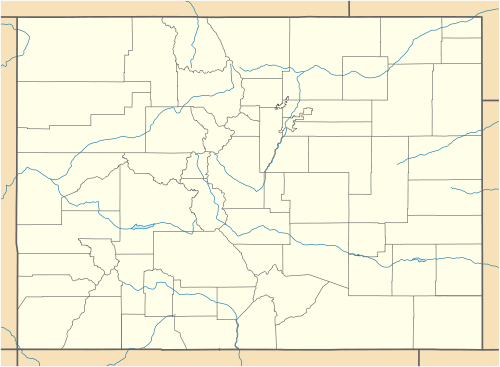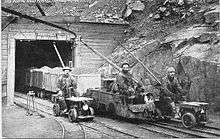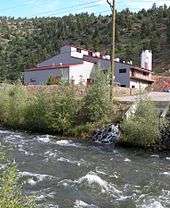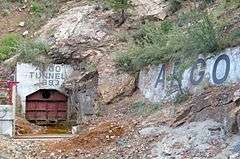Argo Tunnel
|
Argo Tunnel | |
|
Argo Tunnel in 2009 | |
  | |
| Location | 2517 Riverside Dr., Idaho Springs, Colorado |
|---|---|
| Area | 20 acres (8.1 ha) |
| Built | 1893 |
| Architect | Multiple |
| NRHP Reference # | 78000836[1] |
| CSRHP # | 5CC.76[2] |
| Added to NRHP | January 31, 1978 |
The Argo Tunnel, originally called the Newhouse Tunnel (after Salt Lake City mining magnate Samuel Newhouse), is a 4.16-mile (6.69 km) mine drainage and access tunnel with its portal at Idaho Springs, Colorado, USA. The tunnel intersected nearly all the major gold mines between Idaho Springs and Central City, and is the longest such drainage tunnel in the Central City-Idaho Springs mining district.
The mines drained by the Argo Tunnel are no longer active, and the water draining out the tunnel was a source of pollution in Clear Creek until the US EPA began treating the water. Large drainage tunnels in other mining districts include the Sutro Tunnel on the Comstock Lode in Nevada, and the Leadville Tunnel and the Yak Tunnel at Leadville, Colorado.
Although the tunnel itself is not open to the public, the associated gold ore mill and an adjacent gold mine are open to public tours.
History
The Argo Tunnel was started from its southern terminus at Idaho Springs in September 1893, and reached its final length of 4.16 miles (6.69 km) in November 1910, after several pauses in the work. The actual time spent driving the tunnel was nine years and seven months. The tunnel intersected nearly all the major mines between Idaho Springs and Central City.[3]

The tunnel was built on an incline of one-half percent, so that water from the mine workings that it intersected would drain out the entrance at Idaho Springs, rather than having to be pumped out of the individual shafts. In addition, ore cars from the mines could roll downhill to the ore mill at the tunnel entrance, rather than the ore having to be hoisted out of the shafts and trucked to mills. The tunnel was driven in a north-northwest direction, perpendicular to the predominant orientation of the gold veins. It was hoped that the tunnel would intersect previously undiscovered gold veins, but there is no record that important new ore bodies were discovered.
The tunnel operated until January 1943, when miners working on the Kansas Lode near Nevadaville blasted into a water-filled mine working, and a large slug of water flooded out the tunnel entrance, killing the four miners.[4] Shortly after the accident, the federal government ordered all gold mines in the US to shut down, to free men and material to mine metals considered more essential to the World War II war effort. The Argo Tunnel never reopened.
Environmental remediation


Although no longer actively used, the Argo Tunnel continued to drain acid water from the mines, and was recognized as a major continuing source of dissolved metals in Clear Creek. In May 1980, a surge of water flowed from the mine and turned the water in Clear Creek orange for some distance downstream. The temporary large increase in flow was attributed to a roof collapse somewhere within the tunnel damming a large volume of water behind it, then failing suddenly.[5]
The US Environmental Protection Agency listed the tunnel as part of the Central City/Clear Creek federal Superfund site, and built a treatment system at the mouth to neutralize and remove heavy metals from the 700-US-gallon (2,600 L) per minute acid mine drainage flow before it flows into Clear Creek.[6] The treatment system began operation in 1998.[7] The water treatment plant is just west of the old ore mill.
References
- ↑ National Park Service (2010-07-09). "National Register Information System". National Register of Historic Places. National Park Service.
- ↑ "Colorado State Register of Historic Properties – Clear Creek County". History Colorado. Retrieved 16 March 2013.
- ↑ Rens E. Schirmer, "The Argo, or Newhouse Tunnel," Mining and Engineering World, 1 May 1915, p.805.
- ↑ "Argo Tunnel flood traps four and one body is recovered," Denver Post, 19 Jan. 1943, p.1.
- ↑ Peggy Strain, "Clear Creek's orange...'no health threat'," Denver Post, 22 May 1980.
- ↑ US Environmental Protection Agency, Central City/Clear Creek Archived August 29, 2008, at the Wayback Machine., accessed 15 June 2009.
- ↑ Colorado Department of Health and Environment, Clear Creek, accessed 9 July 2009.
See also
Coordinates: 39°44′34″N 105°30′24″W / 39.742867°N 105.506612°W
